| Development from
a Whelp to a young Dog
All through the years
the Irish Terrier breed has fascinated us in a certain way that they became
part of our lives, and we are breeding them with love and understanding.
The following photos are to bring about to the spectators how Irish Terriers
looks like in the different phases of his development from a whelp to
a young dog.
Acquiring an Irish
Terrier has to be well thought on. However pretty a whelp might look like,
on no account should you decide spontaneously. Please consider, you are
now accepting a responsibility to a creature that later on cannot be put
away like any piece of equipment. It is rather important to witness that
you are engaging in a obligation normally lasting for eleven or thirteen
years and even more, a period the Irish Terrier will accompany his family
through "pleasant days and unpleasant ones" on their path through
life. Furthermore it is to be considered that parallel to the ages detailed
below, the imprinting and the education of the whelp or the young dog
will play a vivid part. Especially during the first twelve months of the
young dog you will need a great amount of time and patience.
1st - 4th Week of Live
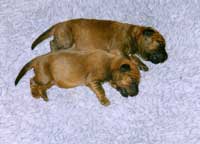 During
his first week of life (newborn phase) the most important occupations
for a whelp are drinking and sleeping. Sucking and swallowing are inborn
to the whelp. When trying to do this the whelp is moving along the body
of his mother with oscilating movements of his head. If he meets a teat
he will try to get hold of it and to suck. When he has satisfied his hunger
he will seek an area of contact as large as possible with his mother as
his own mechanism of regulating warmth has not yet been developed completely.
Movements at that time are still made by the front legs of the whelp due
to the hind legs having hardly got their functionality. During
his first week of life (newborn phase) the most important occupations
for a whelp are drinking and sleeping. Sucking and swallowing are inborn
to the whelp. When trying to do this the whelp is moving along the body
of his mother with oscilating movements of his head. If he meets a teat
he will try to get hold of it and to suck. When he has satisfied his hunger
he will seek an area of contact as large as possible with his mother as
his own mechanism of regulating warmth has not yet been developed completely.
Movements at that time are still made by the front legs of the whelp due
to the hind legs having hardly got their functionality.
A whelp is born with
eyes and ears closed for these sensitive organs are to be protected within
the first days of life. About the eighth day the ears start to get opened
and you may often notice this by the scales forming around the auditory
canals. The eyes start opening about the tenth days. Opening of the eyes
start from the inner corners of the eyelids. At first the eyes of the
whelp still are an opaque blue but becoming clear within about three weeks.
The whelps then will react visually to movements quite evidently.
 Already
shortly after his birth the whelp can communicate with his environment
and especially with his mother in many a vocal expression. He is constantly
moaning whenever he is hungry or he is cold. He will be squeaking aloud
and sharp as soon his mother might step on him by chance or he has fallen
out of the whelping box or he has some sort of pains. The individual utterances
cause particular reactions with the bitch steered by instincts, she will
become uneasy and she will try to bring the whelp back to a satisfying
condition. Already
shortly after his birth the whelp can communicate with his environment
and especially with his mother in many a vocal expression. He is constantly
moaning whenever he is hungry or he is cold. He will be squeaking aloud
and sharp as soon his mother might step on him by chance or he has fallen
out of the whelping box or he has some sort of pains. The individual utterances
cause particular reactions with the bitch steered by instincts, she will
become uneasy and she will try to bring the whelp back to a satisfying
condition.
The birth weight of
an Irish Terrier whelp normally lies between 260 and 300 grams. The average
litter consists of 5.5 whelps per litter.
By having ears and
eyes opened the whelp will now discover his environment and his contacts
will at first take place between his mother, his brothers and sisters,
and the family of the breeder. At this point of time the whelp still has
no teeth.
4th - 6th Week
of Live
 Beginning
between the fourth and sixth week the dentition of the milk-teeth proceeds.
After complete dentition the whelp owns 28 milk teeth. During
this period the thirst for action of the whelp evidently grows, and he
will clearly react on noises answered by growling and even barking. Beginning
between the fourth and sixth week the dentition of the milk-teeth proceeds.
After complete dentition the whelp owns 28 milk teeth. During
this period the thirst for action of the whelp evidently grows, and he
will clearly react on noises answered by growling and even barking.
Commencing about the
fifth week of his life the little dog will definitely climb out of the
litter box 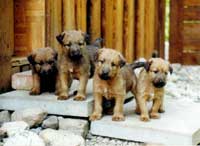 and
will already do their "business" outside his warmly sleeping
place. The breeder now will give additional feed, and it is always exiting
to see a whelp taking his first milk feed. From this time onwards you
have to let have the whelps the opportunity to drop. A free run is now
in demand and not a children's cage in the living room. Raising whelps
only in the house perhaps even on newspapers, is in flagrant contradiction
to the requirements of a whelp. You should have a keen eye on that before
you buy a whelp avoiding being badly surprised at a later date. How to
get a whelp clean rapidly if he is used to do his "business"
in the house or the dwelling? How resistant might be a whelp, which has
never felt real earth under his paws, which has never digged a whole? and
will already do their "business" outside his warmly sleeping
place. The breeder now will give additional feed, and it is always exiting
to see a whelp taking his first milk feed. From this time onwards you
have to let have the whelps the opportunity to drop. A free run is now
in demand and not a children's cage in the living room. Raising whelps
only in the house perhaps even on newspapers, is in flagrant contradiction
to the requirements of a whelp. You should have a keen eye on that before
you buy a whelp avoiding being badly surprised at a later date. How to
get a whelp clean rapidly if he is used to do his "business"
in the house or the dwelling? How resistant might be a whelp, which has
never felt real earth under his paws, which has never digged a whole?
7th - 10th Week
of Live
With his seventh week
the whelp definitely will start his discovery tours and many a breeder
has been astonished on what such a small whelp had been able to do, for
from now on nothing is safe of him. Curiosity and predatory instincts
let have him his experiences as well as his first fights for rank order.
Beginning from that period a good breeder intensively observes his young
dogs as he may learn very much on the characteristics of the individual
whelp.
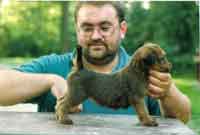 Now
the most time consuming works for the breeder will commence, as the whelps
need a permanent contact to us, the "two legged ones". All that
the whelp may not get during this period can hardly be recovered later
on, as between the seventh and the twelfth week the definite relationship
to the human being is developed by the young dog, well understood relation
with the individual man and not that person he later will live with (imprinting
phase). Parallel to this it would be advisable for the whelps to stay
with their pack as long as possible to learn the necessary social behaviour.
Both of the components mentioned above are essential for the further development
of the young dog. This phase the young dog is passing from his eighth
week to his twelfth and is called period of socialisation. Now it is apparent
why a whelp should hardly be given away at the age of eight weeks, for
who of the future owners might have a pack of dogs to offer to the whelp
to do that job. Mostly the contrary will be the case as they watch over
their new member the same as over their eyeballs and are afraid big unknown
dogs might injure their little ones. Now
the most time consuming works for the breeder will commence, as the whelps
need a permanent contact to us, the "two legged ones". All that
the whelp may not get during this period can hardly be recovered later
on, as between the seventh and the twelfth week the definite relationship
to the human being is developed by the young dog, well understood relation
with the individual man and not that person he later will live with (imprinting
phase). Parallel to this it would be advisable for the whelps to stay
with their pack as long as possible to learn the necessary social behaviour.
Both of the components mentioned above are essential for the further development
of the young dog. This phase the young dog is passing from his eighth
week to his twelfth and is called period of socialisation. Now it is apparent
why a whelp should hardly be given away at the age of eight weeks, for
who of the future owners might have a pack of dogs to offer to the whelp
to do that job. Mostly the contrary will be the case as they watch over
their new member the same as over their eyeballs and are afraid big unknown
dogs might injure their little ones.
You should keep in
mind that all the love and all the educational skill a future owner might
have may never completely compensate any deficiencies in contacts (to
men as well as to packs). Thus already with the breeder a whelp should
get to be acquainted to such things as e.g. car driving, walking on unknown
areas music, clapping pots a.o., to later on becoming a dog we have longed
for so much.
Usually, in the age
of seven weeks the whelp gets his first vaccination. During the first
weeks the whelp got this protection through his mother's milk. With the
amount of additional feeding growing this protection dimishes and the
whelp has to be vaccinated. Building a sufficiently effective protection
it will last the next one to two weeks at least. This period is called
the immunologic lack and is the period with the greatest risk of infection.
Again, a clear argument for the fact why a whelp should not be given to
a new owner during this time, as there is no complete protection can be
guaranteed.
10th - 12th Week
of Live
 The
best age for giving away a young Irish Terrier is starting from the tenth
week on. Especially with a family having children a whelp should not be
passed on too early, as with each further week of life the young dog will
come up better and better with the rushing children. There still is a
further advantage: with the new family the whelp will sleep almost the
whole night through, for from this point of time on the young Irish will
already be quite independent, will not miss his brothers and sisters any
longer and will adapt himself quite good to the new family. The
best age for giving away a young Irish Terrier is starting from the tenth
week on. Especially with a family having children a whelp should not be
passed on too early, as with each further week of life the young dog will
come up better and better with the rushing children. There still is a
further advantage: with the new family the whelp will sleep almost the
whole night through, for from this point of time on the young Irish will
already be quite independent, will not miss his brothers and sisters any
longer and will adapt himself quite good to the new family.
3rd - 4th Month
 Now
that he has been accustomed to his new home a further change of teeth
- that to the permanent teeth - will commence for the young dog at the
age of three months. It is mostly observed by the new owners when the
incisive teeth show apparent gaps, as do small children. Usually the change
of teeth lasts up to the seventh month of age. Now
that he has been accustomed to his new home a further change of teeth
- that to the permanent teeth - will commence for the young dog at the
age of three months. It is mostly observed by the new owners when the
incisive teeth show apparent gaps, as do small children. Usually the change
of teeth lasts up to the seventh month of age.
5th - 7th Month
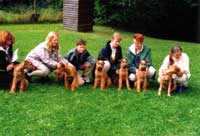 From
the fifth month to the sixth month the pack-ranking phase is ruling and
joining from the seventh month to the twelfth month is the puberty phase.
Simply from the definition the novice to dog education may assume what
he will be facing during this period. During these phases you must consequently
and intensively persist on your educational efforts. You have to consider
that this breed despite all its charm belongs to the category of terriers,
and a terrier is a dog nature has trained to make his way. From
the fifth month to the sixth month the pack-ranking phase is ruling and
joining from the seventh month to the twelfth month is the puberty phase.
Simply from the definition the novice to dog education may assume what
he will be facing during this period. During these phases you must consequently
and intensively persist on your educational efforts. You have to consider
that this breed despite all its charm belongs to the category of terriers,
and a terrier is a dog nature has trained to make his way.
7th - 12th Month
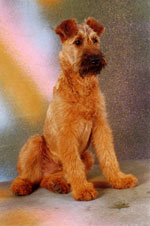 Having
mastered this period of ranking quite good and having realised the first
successes one often thinks during the phase of puberty that all the educational
efforts might have been in vain. Often trained things, especially the
coming on command, will deliberately be ignored. Don't lose courage for
during this phase you will have to stand many a test. Having
mastered this period of ranking quite good and having realised the first
successes one often thinks during the phase of puberty that all the educational
efforts might have been in vain. Often trained things, especially the
coming on command, will deliberately be ignored. Don't lose courage for
during this phase you will have to stand many a test.
Epilogue
However, if after twelve months you do have a true and reliable Irish
at your side and having walked together through pleasant days and unpleasant
ones, then all the youthful pranks will be forgotten and a little bit
you will long for the times our Irish was still a whelp. I assume, this
period of life no one wants to miss despite all the pains it had. This
time will never come back and you should enjoy each and every day
Yours Karina Kirch
|